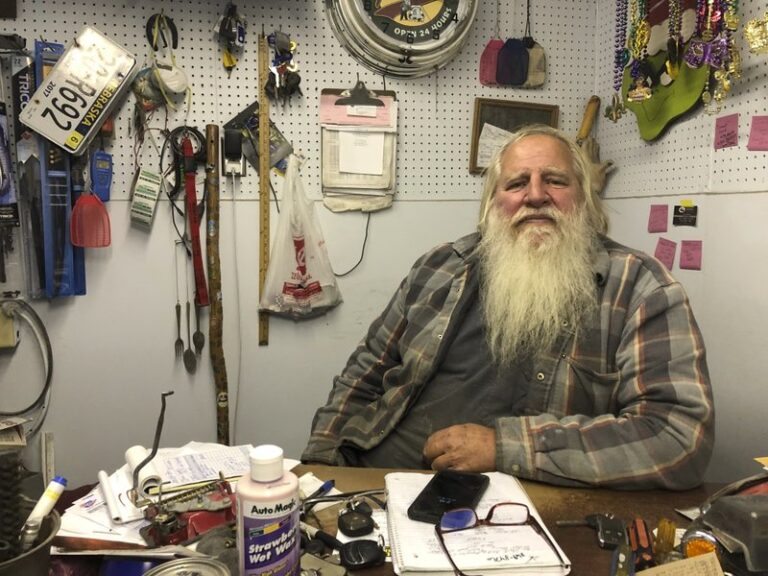
(AP) — Danny Rice has a good sense of how dangerous the coronavirus can be.
What puzzles him are the people who have curtailed so much of their lives to avoid being infected by the virus.
“I’m not going out and looking to catch it,” he said, sitting at a cluttered desk in his auto repair shop in the tiny eastern Nebraska community of Elmwood. “I don’t want to catch it. But if I get it, I get it. That’s just how I feel.”
Plenty of people agree with Rice, and health experts acknowledge those views are powering soaring COVID-19 infection rates, especially in parts of the rural Midwest where the disease is spreading unabated and threatening to overwhelm hospitals.
It’s not that people in Nebraska, South Dakota, North Dakota, Iowa and elsewhere don’t realize their states are leading the nation in new cases per capita. It’s that many of them aren’t especially concerned.
Wayne County, home to 6,400 people in southern Iowa, has the state’s second-highest case rate, yet its public health administrator, Shelley Bickel, says mask-wearing is rare. She finds it particularly appalling when she sees older people, who are at high risk, shopping at a grocery store without one.
“I just want to get on the speaker and say, ‘Why don’t you have your mask on?’ It’s just amazing,” Bickel said.
Jenna Lovaas, public health director of Jones County, Iowa, said even now that her rural county has the state’s highest virus rate, people have opted not to make any changes, such as protecting themselves and others by wearing masks.
“They don’t think it’s real,” she said. “They don’t think it’s going to be that bad or they just don’t want to wear a mask because we’ve made it a whole political thing at this point.”
In part, though, some of those views are hard to fight because of the reality that many people have no symptoms, and most of those who do get sick recover quickly. And treatment advances mean that those who become seriously ill are less likely to die from the virus than when it first emerged in the spring. Even though cases and the death toll are rising, infectious disease experts note that death rates appear to be falling.
Like most people, Jay Stibbe, 52, of Fargo, North Dakota, said he and his family are respectful of COVID-19 protocols and wear masks where required. However, Stibbe said he doesn’t see enough “concrete information” about the virus to stop him from going about his normal life, even though North Dakota leads the nation in the number of virus cases per capita.
“We have an 18-year-old and a 16-year-old, and we certainly believe this is an important time of life to maybe shine a little bit,” he said. “We’re trying to create as much normalcy as we can. We try not to live in fear. We’ve traveled. We go out to dinner.”
In Plattsmouth, Nebraska, Karen Prohaska, 76, said she generally doesn’t wear a mask in her downtown purse and jewelry shop but will put one on at the request of a customer. When customers come into the store with a face covering, she asks if they’d like her to don one as well. Most say no and ask if it’s OK for them to remove theirs.
“I hope that I don’t get the virus, but I’ve never really been a germophobe,” Prohaska said.
The pandemic hasn’t stopped Mary Gerteisen, of Eagle, Nebraska, from visiting her 96-year-old father on weekends to watch football. Gerteisen said she understands the risks, given her father’s age and vulnerability, but she also weighed the fact that he’s in the early stages of dementia and often believes family members have abandoned him.
“There are times when I think that I do need to take the pandemic more seriously,” she said. “But I want to see my dad, and I don’t know much longer I have with him. I would love for him to live to 100-some years old, but if he comes down with (the virus), he’s lived a good, long life.”
Even as virus rates have soared in the Midwest, the Republican governors of Nebraska, Iowa and South Dakota have ruled out requiring masks in all public places, though Iowa Gov. Kim Reynolds this week required masks for indoor events with more than 25 people and outdoor events of more than 100 people. Iowa schools are exempted, and bars and restaurants are only required to ensure social distancing. Meanwhile, North Dakota’s Republican governor, Doug Burgum, imposed statewide mask and business restrictions on Friday after resisting doing so for months. The state had only nine free Intensive Care Unit hospital beds as of Friday.
Although doctors and public health officials have criticized the governors for their lack of action, voters in all of the states last week backed Republicans, including President Donald Trump, who has mocked mask wearing and downplayed the seriousness of a pandemic that has killed more than 240,000 people.
That has left Midwest medical professionals wondering how they will reverse a tide of people being treated for the coronavirus if residents of their states still aren’t taking the illness seriously.
Suresh Gunasekaran, CEO of University of Iowa Hospitals and Clinics in Iowa City, said they’re managing the surge of patients for now but don’t know what will happen if the numbers keep rising.
“The real question is where are we going to be in December? Where are we going to be in January?” he asked. “These are the kinds of questions that I think that we as a state have to continue to ask ourselves but more importantly each local community has to ask themselves.”





